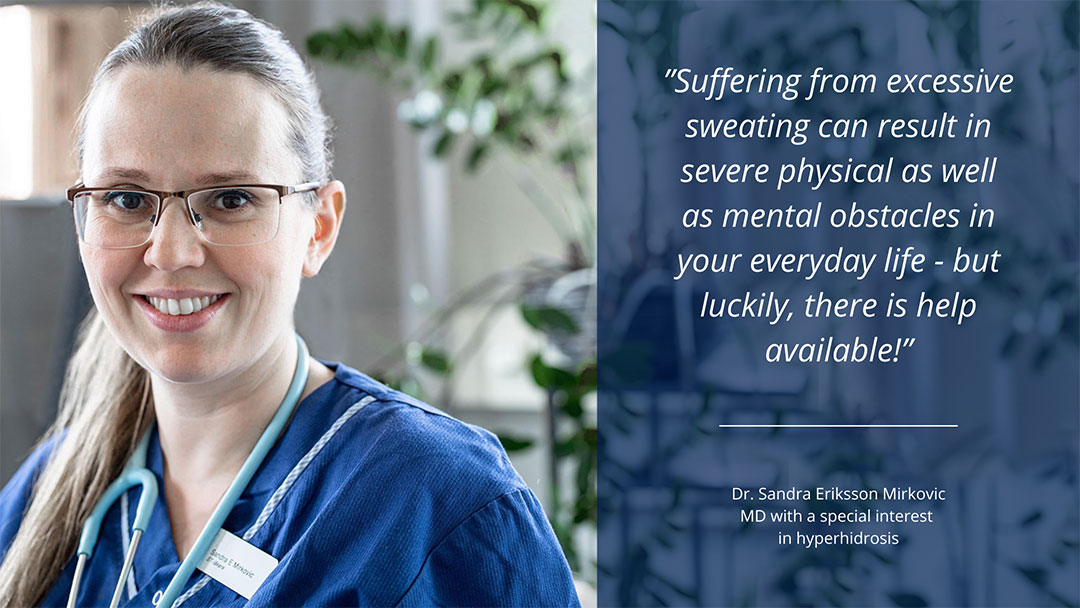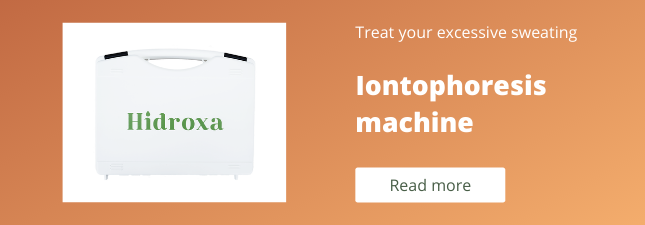Colder times are usually a relief for some hyperhidrosians. It’s usually easier to regulate the warmth and sweating with layered outfits. It’s a huge difference if you think about the summer heat. However, the fight against excessive sweating remains present.
Autumn and winter are an exciting season for members of hyperhidrosis society. Many possibilities open during this period, especially in November, hyperhidrosis awareness month.
Big steps forward in the fight against excessive sweating are happening daily. You can check all the latest news on the hyperhidrosis society website.
One of our main missions at Hidroxa is to make our customers feel safe and comfortable.
Many people wonder if iontophoresis treatments are going to work for them. For those who can not access the clinic to test the machine, we offer a 50-day money-back guarantee. Besides, our customer support is always available for guidance, tips, and advice on best practices.
We are planning to expand our collaboration with more clinics in Scandinavia to start with. We aim for future cooperation with clinics across Europe and worldwide as well. Hopefully, more patients will be able to try out the iontophoresis device before deciding whether they want to purchase it. Now, back to the trips and tricks for dealing with sweat in the winter.
Tips for dealing with excessive sweating in the winter
- Choose your clothing wisely
- Avoid foods that contribute to body odor
- Consider changes to your medical treatments
- Talk to your doctor
Choose your clothing wisely
Your outfit choices can be both your friend and enemy when it comes to handling the sweat in colder times. Particularly when you’re switching a lot between indoors and outdoors.
Some colors and materials could help your skin breathe and hide that you’re sweating.
Others may play against your favor, even if you’re not sweating that much.
Some people with severe hyperhidrosis buy several shirts of the same kind to be able to switch their clothing multiple times during one day without anyone noticing.
Which colors to wear if you’re sweating excessively?
White is one of the few light colors that won’t show your sweat stains as much. However, if the color of the clothing is too bright like yellow, light blue and green, pink, etc. it will become harder to hide the stains.
If your stains aren’t transparent, bright colors like blue, white, green, pink, red, olive, and especially gray are the worst choice.
When it comes to dark colors black, navy, dark brown are one of the best options to hide sweat.
Consider wearing patterns
Patterns like camouflage, floral, checkered, paisley, plaid, and snake print can help you to become a master of disguise. They might not help you sweat less, but they can help you feel less nervous because they won’t show the fact that you’re sweating.
Fabrics that are good choice if you’re sweating
Moisture wicking fabrics:
- Merino Wool
- Bamboo
- Wool
These fabrics “pull sweat away from your body” and are also natural fabrics. They won’t produce as much as unpleasant smells like the artificial ones if you’re suffering from Bromhidrosis as well.
Breathable fabrics:
- Cotton
- Linen
- Rayon
These fabrics are great if you want to let your skin “breathe”. Any possible body odor (bugging people that suffer from both hyperhidrosis and bromhidrosis) will evaporate much faster.
Most of people with hyperhidrosis usually don’t have a problem with odor. In some cases, it can be a possible issue if sweat isn’t coming from the feet.
Foul smelling sweat is a condition named Bromhidrosis.
Fabrics that contribute to smell and odor production and might be good to avoid:
- Polypropylene
- Nylon
- Polyester
Wear layers
The weather is the most unpredictable in this season. Wearing layers is an effective strategy to stay comfortable in the winter. Frequent changes in temperature are harder to handle if you haven’t chosen your layers wisely. Here are the tips for clothing layers to help in the fight against sweating above normal:
- Wear an undershirt and undergarments under your outfit. They can often absorb a certain amount of sweat, so the amount of sweat on the surface will lessen.
- Consider bringing a jacket with you. When the sweat starts to act crazy, and you’re in a hurry for a meeting or an important appointment, you can put the jacket on to feel more comfortable. Bonus tip: If your jacket has pockets, you can put a handkerchief in it to wipe the sweat out of your face or palms.
Avoid drinks that contribute to your body sweating
Alcohol consumption affects the central nervous system, widens blood vessels, which causes the body temperature to increase. To fight off the temperature, our bodies produce more sweat to cool us off.
According to alcohol.org, the mechanism isn’t fully known yet.
With diminished levels of this enzyme, it’s thought that certain toxic metabolic by-products build up in the body and can cause flushing in the skin.
Some people experience less sweating when they are consuming alcoholic beverages. This happens because they feel relaxed and their sympathetic nervous system is calm.
Consider changes to your hyperhidrosis treatments
Different temperatures can produce changes in the way you sweat. Sometimes, colder times like autumn are a time of relief for some people, because their sweating decreases. For others, it can be the exact opposite. There can be no sign of any changes in the sweating level.
Being careful with what you’re wearing and eating will probably not be enough to deal successfully with hyperhidrosis.
As the first step of your anti-sweat mission, you can try using prescribed antiperspirants or over-the-counter antiperspirants. Other types of medications could help to have more control over your sweating.
Usually, at this step, most people find themselves disappointed seeing minimal or no results at all. These medications often aren’t enough to treat this medical condition.
If you’re already using medications, and you see that this effect is wearing off, you should consider researching other options. If you have the opportunity to do so in your area, look for a doctor with experience in hyperhidrosis treatment to advise you about treatment options.
Talk to your doctor about excessive sweating
Using medications properly is the most important thing when it comes to fighting hyperhidrosis – excessive sweating. If you’re considering adding extra medications to your treatment plan or intensifying the use of the existing ones, you should talk to a doctor specialized in this area. Sometimes, depending on the type of the treatment or medication, you can experience no changes at all. Some medication can cause hyperhidrosis as a side effect.
However, if a person is dealing with other serious conditions, it is necessary for them to continue taking them. In these situations, it’s essential to learn how to manage the increased level of sweat. Hyperhidrosis that is a result of taking medications is known as secondary hyperhidrosis.
The doctor can explain to you the possible benefits and disadvantages of using the medication in general. Also, they can educate you about the particular effect in the time of the year like winter.
Conclusion
Winter symbolizes more relaxed times for most people who are suffering from excessive sweating, but the fight against it continues. It’s easier to hide the sweat stains and feel less ashamed by wearing particular colors and layers. The most important thing is to think up-front so you’re ready at every moment.
Thinking carefully about the colors and layers while dressing is a good tactic to cover up a sweat. However, it won’t help you lessen the sweat level significantly. That’s why it is important to use medications or treatments that can help you take control of your excessive sweating.
Before considering any adjustments to your treatment plan, reach out to your doctor. They can present you with information on certain medications and treatment options.

Customer service and digital marketing specialist motivated to spread awareness about hyperhidrosis and help patients in finding the right treatment.

